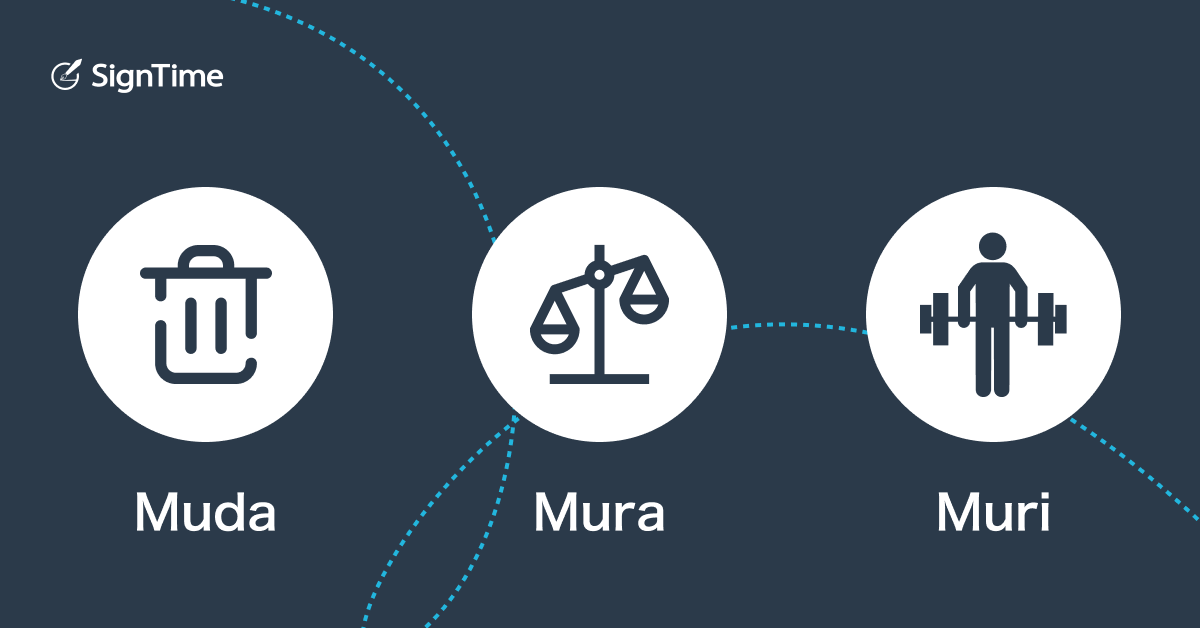release:
AI, e-Signatures, Elimininating Muda, Mura and Muri from office work

Japan: High Tech Economy, Analog Back Office
One of the observations first time visitors have of Japan, is how incredibly modern and high-tech the country is – while at the same time, suffering from “back office” processes that seem antiquated and get in the way of even greater modernization. While there is a well known Internet meme about “Japan faxes” (in reference to a technology that is rarely used elsewhere), OECD data shows that Japan ranks 29th of the 38 countries, with only a little more than half of the productivity of the United States.
At SignTime, we’re seeing the start of a wave of modernization in Japanese businesses, where firms are making serious headway in moving their analog back office processes to “all electronic.” This wave of Digital Transformation (DX) is proceeding rapidly as a tight labor market and aging professional workforce demands even greater productivity in each business.
SignTime’s core mission is to help Japanese businesses bring all analog based workflows online. This mission fits with our vision, inspired by Toyota’s lean production process, where we eliminate Muda (waste), Mura (unevenness) and Muri (unnecessary strain) for back office work.
What is Muda, Mura and Muri?
Muda, Mura, and Muri are key concepts in lean management, developed as concepts by Toyota in the management of their production systems, that help identify and eliminate inefficiencies in processes.

Muda refers to waste—any activity or resource that doesn’t add value to the customer. For a factory, this could include unnecessary steps, overproduction, defects, waiting times, and excess inventory. In an office environment, this would include manual re-entry of data, physical paper and/or hanko requirement for approvals, processes which historically required certain steps but no longer do, and an overreliance on physical paper and/or forms for business processes.

Mura refers to unevenness or inconsistency in a process. It occurs when production or work is not balanced, leading to fluctuations in workload or performance as items back up at bottlenecks. The most obvious example of Mura for a white collar employee would be a paper with multiple approvals on it that sits in an intray (or even an in-box) receiving no action and creating an unnecessary backlog for workers who are trying to get things done. Mura is probably the most frustrating of these items, as the process is underway, but there is no visibility to when it will be complete.

Finally, Muri is ‘overburden’ or ‘strain’, which happens when workers, equipment, or processes are pushed beyond their capacity. It leads to mistakes, breakdowns, and burnout. Some of Japan’s bubble era work culture of excessive overtime and a lack of pay for performance led to white collar personnel trying to show dedication by working long hours regardless of work product produced. At SignTime, our vision is of a future Japan workforce which eliminates Muda, Mura and Muri – in the back office.
How can e-Signatures and internal workflows help improve productivity and reduce waste?
SignTime offers a range of electronic signature solutions that streamline document management, especially for businesses needing secure, fast, and scalable e-signature and easy to use approval/workflows. Our offerings and design are customer driven, focused on ensuring documents flow smoothly and stay digital. We started with e-signatures and document templates, added bulk sending, document tracking and SMS sending, and offer long-term cloud storage solutions with both our PrimeTime plan and our ScanTime product. These tools are designed to simplify the e-signature process, reduce administrative work, and enhance security, while also supporting a host of integrations with third-party services like Salesforce and Google Drive.
When applying the concepts of Muda, Mura, and Muri to SignTime’s solutions, Muda (waste) can be minimized by eliminating redundant steps in document processing and handling. For example, SignTime’s bulk sending features and automated workflows reduce the manual effort involved in sending and managing documents. With the ability to have management review of a document as part of an internal workflow before it goes for signature with a client, Mura (unevenness) can be addressed through tools like internal approval workflows and automated alerts, ensuring smoother, more predictable document handling. One of the great advantages of integrations like Salesforce.com with SignTime is that data remains digital end to end.
Lastly, Muri (overburdening) – SignTime has always focused on ease of use, whether it is the ability to upload word files (rather than just PDFs), sending via SMS for signature and other mobility solutions. Our fundamental design principle was best summarized by one of our clients who said “with SignTime, I never need a manual”. Overall, SignTime’s products help businesses streamline their contract management, contributing to more efficient and balanced business processes.
How does AI fit into this?
We have already talked to some degree about AI integrations that we are working on, so at the risk of repeating ourselves, let us run through some of the more tangible cases we see.
AI-driven features beyond the e-signature such as metadata management, reporting, and auto-generation of summaries and indexes streamline document processing by reducing manual effort and minimizing errors, thus eliminating waste (Muda). Additionally, AI will facilitate context actions that provide users with relevant options based on document content, further optimizing workflows.
Looking ahead, SignTime plans to incorporate AI features like tagging, compliance and error checking, and autodesign. Tagging will enable efficient organization and retrieval of documents, reducing inconsistencies (Mura) in document management.
Compliance and error checking will automate the verification of document accuracy and adherence to regulations, preventing overburden (Muri) on staff and reducing the risk of mistakes. Autodesign aims to simplify document formatting, making the process more intuitive and less taxing for users.
These AI enhancements collectively contribute to more efficient, balanced, and sustainable business processes for SignTime customers.
Four Near Term Use Cases
AI is revolutionizing e-signatures and electronic contracting workflows. Here are four areas where AI will be enhancing the SignTime platform to improve efficiency for users.
- Meta-Data Auto-population: Identify and auto-populate document descriptors like tags, counter-parties and other “search” or “compliance” focused items
- Auto-layout on screen for fields–users will be able to upload a document, auto-convert it to a template, take the parties out and put fields in their places instead
- Internal Consistency Checks: e.g. ”You mention Appendix A, but there is no Appendix A”
- AI Enhanced Store and Search:
Document evaluation “Instead of a person running a spreadsheet with information about your agreements, have SignTime AI do it:- Type
- Counterparties
- Addresses
- Amounts
- Renewal dates
- “Query Example: SignTime, could you please bring me all contracts that auto-renew in the next six months?”
Conclusion
These and other coming AI enhancements will collectively contribute to more efficient, balanced, and sustainable business processes for SignTime customers. Any business processes that utilise forms, contracts or any other similar documentation, especially those that are paper based, can be eliminated and dramatically enhanced with the SignTime platform. Eliminating the 3Ms – Muda, Mura and Muri – can help any business transform its internal and external business processes, returning time and improving productivity throughout the enterprise.
